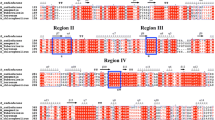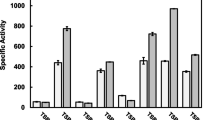Abstract
Trehalase, which hydrolyzes the disaccharide trehalose to α-d-glucose was isolated and partially purified (124-fold) from the phototrophic halo-alkaliphilic bacterium Ectothiorhodospira halochloris. The molecular mass was determined to be 480,000 and the isoelectric point pH 5.6. Temperature optimum was found to be 40°C and the pH-optimum 7.8–8.1. In spite of its high K m-value of 0.5 M, trehalase of E. halochloris was shown to be specific for trehalose. Trehalase is activated by phosphate which is, however, not involved in the reaction mechanism. The enzyme is activated by the compatible solute betaine and inhibited by salts. In the presence of betaine the K m-value is lowered from 0.5 M to 0.16 M; moreover, betaine partially protects enzymatic activity from salt inhibition. The findings indicate that betaine might regulate the trehalose level in the cells by affecting trehalase activity.
Similar content being viewed by others
References
BelocopitowE, MaréchalLR (1970) Trehalose phosphorylase from Euglena gracilis. Biochim Biophys Acta 198:151–154
BergmeyerHU (1974) Methods of enzymatic analysis, vol VI. Verlag Chemie, Weinheim, pp 163–198
BodeR, BirnbaumD (1986) Threonine dehydratase activity from several yeast species is activated and affected by phosphate. FEMS Microbiol Lett 37:189–192
BoosW, EhmannU, BremerE, MeddendorfA, PostmaP (1987) Trehalase of Escherichia coli. J Biol Chem 262:13212–13218
BradfordMH (1976) A rapid and sensitive method for the quantitation of microgram quantities of protein utilizing the principle of protein-dye binding. Anal Biochem 72:248–254
BrownAD (1976) Microbial water stress. Bacteriol Rev 40:803–846
CollinsKD, MashabaughMW (1985) The Hofmeister effect and behaviour of water at interfaces. Quarterly Rev Biophys 18: 323–422
CroweJH, CroweLM, ChapmanD (1984) Preservation of membranes in anhydrobiotic organisms: the role of trehalose. Science 223:701–703
Cruz MartinM, DiazLA, ManzanalMB, HardissonC (1986) Role of trehalose in spores of Streptomyces. FEMS Microbiol Lett 35:45–54
ElbeinAD (1974) The metabolism of α,α-trehalose. Adv Carbo Chem Biochem 30:227–256
FriedenC (1970) Kinetic aspects of regulation of metabolic processes. J Biol Chem 245:5788–5799
GalinskiEA, HerzogRM (1990) The role of trehalose as a substitute for N-containing compatible solutes (Ectothiorhodospira halochloris). Arch Microbiol 153:607–613
GalinskiEA, TrüperHG (1982) Betaine, a compatible solute in the extremely halophilic phototrophic bacterium Ectothiorhodospira halochloris. FEMS Microbiol Lett 13:357–360
GalinskiEA, PfeifferHP, TrüperHG (1985) 1,4,5,6-Tetrahydro-2-methyl-4-pyrimidinecarboxylic acid. A novel cyclic amino acid from the halophilic phototrophie bacteria of the genus Ectothiorhodospira. Eur J Biochem 149:135–139
ImhoffJF, TrüperHG (1977) Ectothiorhodospira halochloris sp. nov., a new extremely halophilic phototrophic bacterium containing bacteriochlorophyll b. Arch Microbiol 114:115–121
KemekuraM (1986) Production and function of enzymes of eubacterial halophytes. FEMS Microbiol Rev 39:145–150
LarsenPI, SydnesLK, LandfaldB, StromAR (1987) Osmoregulation in Escherichia coli by accumulation of organic osmolytes: betaines, glutamic acid and trehalose. Arch Microbiol 147: 1–7
LopezMF, TorreyJG (1985) Purification and properties of trehalase in Frankia ArI3. Arch Microbiol 143:209–215
MackayMA, NortonRS, BorowitzkaLJ (1984) Organic osmoregulatory solutes in cyanobacteria. J Gen Microbiol 130: 2177–2191
MaurerJH (1971) Disc electrophoresis and related techniques of polyacrylamid gel electrophoresis. Walter de Gruyter, Berlin New York
PollardA, Wyn JonesRG (1979) Enzyme activities in concentrated solutions of glycinebetaine and other solutes. Planta 144:291–298
ReedRH, RichardsonDL, WarrSRC, StewartWDP (1984) Carbohydrate accumulation and osmotic stress in cyanobacteria. J Gen Microbiol 130:1–4
RudolphAS, CroweJH (1985) Membrane stabilization during freezing: the role of two natural cryoprotectants, trehalose and proline. Cryobiology 22:367–377
StreeterJG (1982) Enzymes of sucrose, maltose and α,α-trehalose catabolism in soybean root nodules. Planta 155:112–115
TheveleinJM (1984) Regulation of trehalose mobilization in funghi. Microbiol Rev 48:42–59
TrüperHG, GalinskiEA (1986) Concentrated brines as habitats for microorganisms. Experientia 42:1182–1187
Tschichholz I, Trüper HG (1990) Fate of compatible solutes during dilution stress in Ectothiorhodospira halochloris. FEMS Microbiol Ecol (in press)
VanLaereA (1989) Trehalose, reserve and/or stress metabolite. FEMS Microbiol Rev 63:201–210
WarrSRC, ReedRH, StewartWDP (1984) Osmotic adjustment of cyanobacteria: the effects of NaCl, KCl, sucrose and glycine-betaine on glutamine synthetase activity in a marine and a halotolerant strain. J Gen Microbiol 130:2169–2175
YanceyPH, ClarkME, HandSC, BowlusRD, SomeroGN (1982) Living with water stress: evolution of osmolyte systems. Science 217:1214–1222
Author information
Authors and Affiliations
Rights and permissions
About this article
Cite this article
Herzog, R.M., Galinski, E.A. & Trüper, H.G. Degradation of the compatible solute trehalose in Ectothiorhodospira halochloris: isolation and characterization of trehalase. Arch. Microbiol. 153, 600–606 (1990). https://doi.org/10.1007/BF00245272
Received:
Accepted:
Issue Date:
DOI: https://doi.org/10.1007/BF00245272




